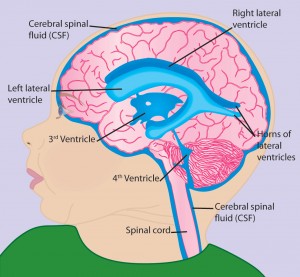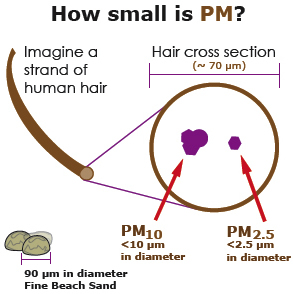Posts Tagged ‘Soot’
“Another Study Links Air Pollution to Autism” x4
 One of the areas of environmental health research that's producing almost monthly results is the varied and pernicious adverse human health effects of tiny particulate matter, or soot.
One of the areas of environmental health research that's producing almost monthly results is the varied and pernicious adverse human health effects of tiny particulate matter, or soot.
Once only blamed for respiratory problems and then heart attacks, it's now associated with a high blood pressure, strokes, immune system damage and a wide range of neurological diseases and conditions, including IQ loss, Parkinson's, and early dementia. That's because the particles are so small they pass through the lining of the lung and into a person's blood stream and can end up anywhere, including the brain.
Late last week saw the latest study to link PM pollution to autism. It was the fourth major study to do so in the last two years alone. But unlike the previous three, which found an epidemiological association between exposure to PM and the rate of autism in a community, this one may actually begin to explain the physiology of how PM attacks the brain:
"Researchers at the American Association for the Advancement of Sciences (AAAS) annual meeting in Chicago recently detailed the impact that constant exposure to air pollution may have on the developing brain. According to the panel, a series of mouse models have suggested that constant inhalation of air pollution may lead to enlargement of the brain’s ventricles – a hallmark of neurodevelopmental disorders such as schizophrenia and autism."
A brain's ventricular system is a set of four structures containing cerebrospinal fluid (CSF). It's continuous with the central canal of the spinal cord. Cerebrospinal fluid helps to protect the brain, keep it clean and boost its energy. When these ventricles are enlarged, it often indicates a damaged central nervous system. Dr. Deborah Cory-Slechta of the University of Rochester School of Medicine says that's what they found after exposing mice to PM pollution
“When the brain ventricles are too big, it pushes on the rest of the tissue,” Cory-Slectha said. “Also, you have these tracks of what’s called ‘white matter.’ And they cross over the brain; they connect the two hemispheres. And in these mice, those are either missing, or never developed, or died. We don’t know which, but a lot of that is missing, and that too is very characteristic of autism and schizophrenia.”
Ventriculomegaly – the enlargement of the ventricles – is also associated with a range of other brain diseases, such as bipolar disorder and Alzheimer’s disease, as well as a number of birth defects in children. Cory-Slectha noted that this brain damage was largely seen in the male rodents – an interesting finding given that both autism and schizophrenia are mainly male-oriented conditions.
“And part of that that is so interesting is both autism and schizophrenia, not only are they primarily in males, but the rates of those have been going up,” Cory-Slectha said. “And yet nobody can really ever explain why. [They say] it’s the diagnoses, etc. Well you know, air pollution has also gotten worse in some places, and you are exposed to it your entire life. So now we have the [epidemiological research] and we have the animal studies [to support that].”
She's right. We already have very strong correlations between levels of PM pollution and autism that this animal toxicology study now dovetails. Last June, the National Institute of Environmental Health Sciences published a study showing that women living in high air pollution areas while pregnant are up to twice as likely to have a child with autism as those living in less polluted areas.
In March of last year, researches at UCLA published a study showing the more Ozone and Particulate Matter pollution a baby in the womb is exposed to, the more likely he or she will be born with autism. It was the largest study of its kind to date.
In November of 2012, another UCLA study found that children who are born and live their first year closer to major freeways also suffer a significantly elevated risk of autism.
Scientists now know that there is no safe level of exposure to tiny PM pollution, called PM 2.5 because it's 2.5 microns or smaller. Any amount is capable of harming someone, especially if that someone is a child, senior citizen, or already ha health problems. And yet, regulatory agencies pretend this science doesn't exist – otherwise it would be very hard to issue permits for tons of new PM pollution, which they do almost every week.
There's been an explosion in the rate of autism in the US over the last 30 years. Could air pollution account for at least a sizable portion of that increase? The science is saying yes.
EPA Interpretation of Soot Regs Under Fire
 In an important challenge to the way EPA has gone about regulating the tiniest and most harmful forms of soot, or "Particulate Matter" pollution, attorneys for environmental groups seem to making some headway in the courts.
In an important challenge to the way EPA has gone about regulating the tiniest and most harmful forms of soot, or "Particulate Matter" pollution, attorneys for environmental groups seem to making some headway in the courts.
Currently, EPA is about to recommend new PM pollution rules that will reportedly lower the exposure standard for "PM 2.5" – that is, soot that's 2.5 MICRONS or less in size. A human hair is about 10 microns wide, so we're talking incredibly small particles that can easily find their way into your lungs, and then pass through directly into your blood stream.
However, when the Clean Air Act was amended in the early 1990's, the danger of PM pollution was confined to "PM 10" – particles 10 microns or less in size. So called "Coarse PM." But research over the last 20 years has pointed to the greatest danger to human health coming from the smallest kinds of PM pollution – the stuff that's 2.5 or smaller. It's been linked at very low levels of exposure not only to respiratory disease, but to heart attacks, strokes, and brain diseases similar to Parkinson's and Alzheimer's. In fact, the consensus among researchers now is that there is no level of exposure to PM 2.5 pollution that's not capable of doing some harm, that is, there is no "safe level" of exposure.
In another example of how regulations don't keep pace with science, EPA is still regulating PM 10 standards stricter than they are PM 2.5 standards, even though we now know that it's the smallest stuff that is more harmful. EPA is actually using another part of the Clean AIr Act to regualte PM 2.5 pollution than it uses to regulate PM 10 pollution. And the provision it uses for PM 2.5 allows states a lot more wiggle room than the tougher PM 10 provisions.
PM 10 pollution pouring out of a smokestack includes all PM 2. 5 pollution. But "PM 2.5 polluiton"excludes the larger coarser soot. Clear?
One of the three judges of the US Court of Appeals for the District of Columbia, David Tatel, had a hard time with the fact that EPA went outside it's own PM 10 rules to regulate a sub-set of more dangerous PM 10.
"I don't see why it makes much sense to separate out the fine particles," Tatel said. "I don't understand why the agency would do this.' Tatel indicated he did not believe the Clean Air Act required EPA to handle fine particulate matter differently than the coarser pollutants. References in the statute to PM 10 seemed to indicate Congress was referring to particulate matter in general, which would include PM 2.5, Tatel said."
This is exactly the argument EarthJustice lawyers were using. When the Clean Air Act says "fine particles" it means PM 10 and PM 2.5 – you can't regulate PM 10 without also regulating PM 2.5. But this is a law of physics that EPA is trying to undo. The Agency is actually arguing that Congress only meant to apply the standards to PM 10 pollution and no other "fine particles." It's also arguing that the challenge is a decade too late, since the original rules were passed in 1997. The judges didn't seem to be buying that defense either.
With brand new EPA regs for PM pollution expected to be announced shortly, one could reasonably assume this is mostly an academic exercise. but it's not. First, these old rules will still be in play for some time as the new ones are phased-in. It's important to get it right in the intervening period. These old regs affect PM emissions from cement kilns, boilers of all types, power plants and even cars and the public health impact of a stricter standard could be significant. Second, the interpretation EPA uses to establish the new rules could rest on whether the courts agree that it used the right provisions and language last time out.
We've been saying this a lot lately, but it's true. PM pollution is the most insidious, dangerous, and widespread form of air pollution in the world today. It is the ozone of the 21st Century in terms of how pervasive its effects are, and the size of the regulatory response to counter that harm.
